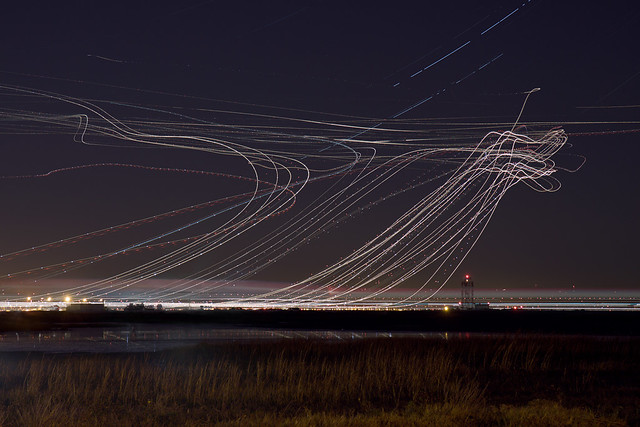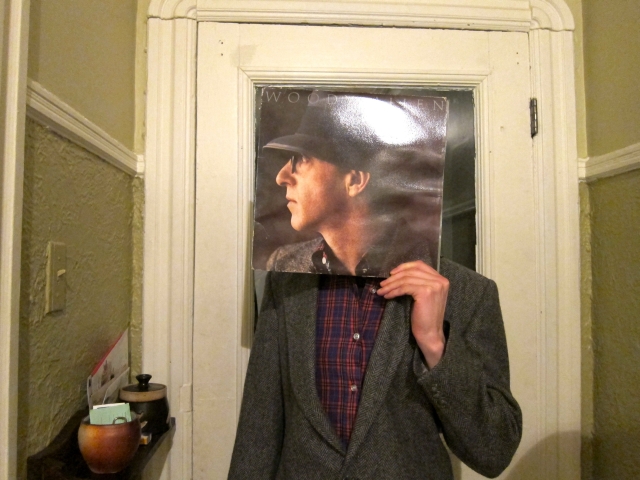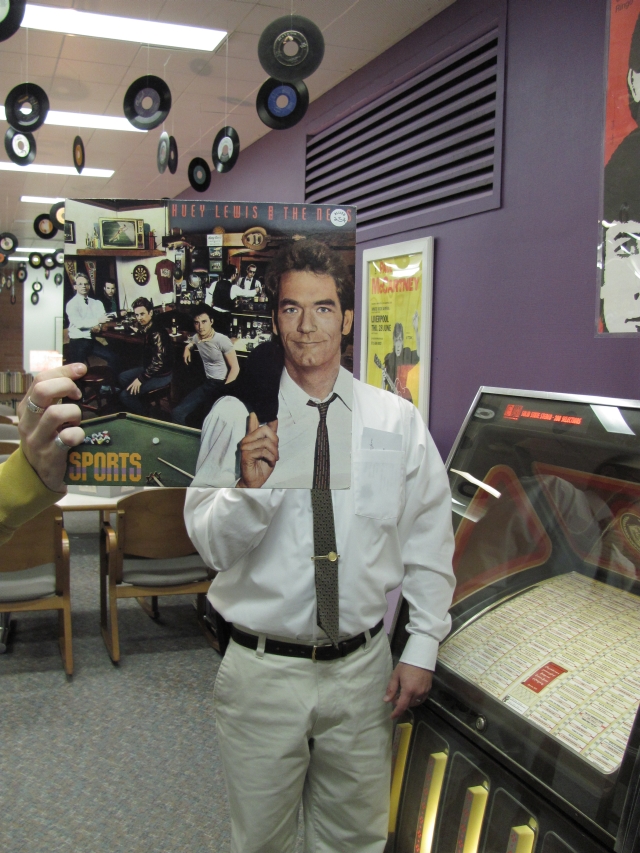Long exposure photography is pretty cool, combined with a bit of overlaying and you’ve got an interesting way to chart the movements of aircraft around an airport..


More in the Flickr Set.
Long exposure photography is pretty cool, combined with a bit of overlaying and you’ve got an interesting way to chart the movements of aircraft around an airport..


More in the Flickr Set.
This one is from a mountain and has nice stars.
The Mountain from TSO Photography on Vimeo.
This little photographic excursion to Ikea tightens the allen-keyed cockles of my heart.
Two guys made themselves at home in the Swedish superstore.


Via 22 Words, days ago. I’d find the link if I could be bothered.
This is great. Get an album cover. Match up your outfit. Hold the album in front of your face with the edges lined up.
And you have a Sleeveface.


There’s a collection of such Sleevefaces here.
Via ChurchCreate.
Some very useful photography tips, not just food photography tips, from Serious Eats here (there’s a Serious Eats cook book coming out at the end of the year – fantastic news, it’s available for pre-order on Amazon
).

I take a lot of food photos, more coffee photos though… for my coffee blog. Here are my tips.
1. Buy an iPhone.
2. Download Instagram.
3. Take a photo of your food with Instagram from a cool angle.
4. Choose a filter.
Well blog friends, it has been a quiet old time here the last few days. Hopefully that is all about to change. Part of the reason for the said quietness was the aforementioned essaying. But we also spent the last few days on Robyn’s folk’s farm near Dalby, and despite one of my jobs on the farm being to set up the wireless internet connection, I didn’t spend a whole lot of time on the computer.
This trip to the farm was fun. We took our Canadian friends Mitch and Steph (check out Mitch’s photo blog) along for the ride. Mitch and Steph have travelled all the way from the mystical Canadaland to study with us at the Queensland Theological College. In Canada, amongst other things, Mitch was a poo farmer. Seriously. I think that is fantastic. And they are good company. So we introduced them to a little bit of Australiana. Dalby style.
Here are some photos from the weekend.
This yellow pole thing is called an “auger” or something. It was made in Mitch and Steph’s tiny home town in Canada. Which amazed them. They couldn’t stop talking about it.
Mitch even had me jumping for joy over it. Until I kicked my heel a little bit too hard. And then I was just jumping because I was told to.
We found a red belly black snake.
And then played with some long exposure photography “light painting”…
On Easter Sunday we had an Easter egg hunt, went wallaby hunting on the Bunya Mountains, and drove home (via Mt Cootha). It was a pretty busy weekend. But lots of fun.
How was your Easter?
If there’s one truth I’ve learned in my time on the Internet it’s that people will be at least 25% meaner behind a keyboard. Unless they put their real name to what they’re writing, but even then they’re probably 10% meaner because so much of communication occurs outside the words we use.
But this is just hilarious.
David Foster Wallace is considered by many to be one of the written voices of his generation. His essays regularly (and posthumously) appear in lists of the best essays ever written. He wrote some books. Including a book called Infinite Jest.
Somebody posted the first page of the book to Yahoo questions asking for “feedback”… hilarity ensued.
“This needs some serious work… your writing is not formal… it is written in informal language that imitates the qualities commonly believed to be characteristic of formal language.
I recommend checking out “The Elements of Style” by William Strunk and E.B White… that should help to clear a few things up.”
And another:
“You know your story needs more work, so you don’t need anyone to tell you what you already know.”
And another…
“No discernible voice/tone in this writing. Rambling descriptions. I, frankly, do not care where each and every person is seated. I don’t care what shoe you’re wearing.
If you take out all the unnecessary details, you’d be left with about seven words.”
Something similar happened on Flickr, when a photo by the pioneer of photo-journalism, Henri Cartier-Bresson, was put up in a “Deleteme” thread – where “good photographers” comment on the work of budding photographers by voting to save or delete the photo.
In this case this photo was roundly condemned, and advice was distributed to the photographer (for some reason this photo has been flagged as inappropriate and you have to log in to Flickr to see the thread)…
Here’s the photo.

Some of the comments:
“hard to tell at this size but is everything meant to be moving in this shot, all seems blurred”
“so small
so blurry
to better show a sense of movement SOMETHING has to be in sharp focus”
“This looks contrived, which is not a bad thing. If this is a planned shot, it just didn’t come out right. If you can round up Mario, I would do it again. This time put the camera on a tripod and use the smallest aperture possible to get the best DoF. What I would hope for is that the railings are sharp and that mario on the bike shows a blur. Must have the foreground sharp, though. Without that, the image will never fly.”
There are a couple of things going on in these situations for me – one is the idea that an artist’s name or reputation is enough to turn something substandard into something that people will describe as a “masterpiece,” while the other is that there’s a big difference between being educated and believing you’re educated – all these “experts” on both forums are assessing these works based solely on their own personal preferences developed by their own environment and experience.
Those two examples of this phenomenon at play – Dunning-Kruger meets the internet forum meets modern art – came from Kottke.org, and remind me of this little story, where Joshua Bell, one of the world’s most famous violinists played one of the world’s most expensive violins (with a $3 million plus price tag), at a train station, and nobody noticed. This was an experiment conducted by the Washington Post and covered in this story.
In the three-quarters of an hour that Joshua Bell played, seven people stopped what they were doing to hang around and take in the performance, at least for a minute. Twenty-seven gave money, most of them on the run — for a total of $32 and change. That leaves the 1,070 people who hurried by, oblivious, many only three feet away, few even turning to look.
It was all videotaped by a hidden camera. You can play the recording once or 15 times, and it never gets any easier to watch. Try speeding it up, and it becomes one of those herky-jerky World War I-era silent newsreels. The people scurry by in comical little hops and starts, cups of coffee in their hands, cellphones at their ears, ID tags slapping at their bellies, a grim danse macabre to indifference, inertia and the dingy, gray rush of modernity.
The Washington Post piece points out the truth underlying the responses to the written works of David Foster Wallace, and the picture by Henri Cartier-Bresson. Context is king. Art requires a frame. Something to point out why people should sit up and take notice, this is the only truth that keeps the doors of the Gallery of Modern Art open – a frame provides a point of reference.
“When you play for ticket-holders,” Bell explains, “you are already validated. I have no sense that I need to be accepted. I’m already accepted. Here, there was this thought: What if they don’t like me? What if they resent my presence . . .”
He was, in short, art without a frame. Which, it turns out, may have a lot to do with what happened — or, more precisely, what didn’t happen — on January 12.”
Fascinating stuff.
Ahh Sydney.
So, today, we walked down King St, visited Moore College (where we stood in a corner and people watched and my wife was shocked by how young and cool Con Campbell looked, she had pictured him as a 60 year old englishman), walked to Redfern, caught a train going in the wrong direction, so we caught a different train. Then, finally, we arrived at our destination – Mecca Espresso on King St in the CBD (not to be confused with the aforementioned King St).
I’ll be reviewing Mecca on thebeanstalker.com, but I tried my first ever Clover brew. The Clover, when released, was a $15,000 piece of technology. It’s the black box in the middle on this bench:
It was nice. Smelt like fruity tea. Tasted like coffee.
We spent the morning with my friend Paul. Which was tops. Then walked to Circular Quay, caught the ferry to Taronga, and walked around the zoo for the afternoon. Which Robyn loved and I enjoyed.
There were turtles.
And rabbit-eating dragons…
And primates.
And other animals.
Though, some were missing…
Then it was a reversal of the morning, though we added dinner at a cheap Greek place, and about 45 minutes poring through the shelves at Gould Books.
A good day.
I love instagram. It’s possibly my most used iPhone app. Almost all of my cafe reviews on thebeanstalker.com use it. And why not.

But one of the downsides of instagram is its lack of web presence. You don’t get a profile, you have to have the link for each photo you’ve uploaded from wherever you’ve uploaded it to (be it Facebook, Twitter, Tumblr, Flickr, etc) to get to the photo’s native location on the instagram server.
Instagram is rumoured to be working on a nice web interface. It’s coming. So they say. But in the meantime check out this neat little 3rd party service called webstagram. All you need is the person’s username and you’ve got a nice little instagram profile.
I’m guilty. Partially. Of taking the same iconic tourism shot as everybody else. Though I also learned this lesson back in my tourism marketing days – so I’m much more interested in taking photos of people, or odd angles, or trying to do something unique, than I am in taking the same picture that features on post cards you can buy for a dollar – though those do have a place if you’re on a study tour (hence their appearance in the albums from the Greece and Turkey trip we went on last year).
When an artist named Corinne Vionnet noticed that everybody in the world seems to take the same photos she put together this exhibition of overlayed photos of some of the wonders of the tourism world.
“Switzerland-based Corinne Vionnet is our guide to the world’s most famous landmarks, monuments millions have visited before. Her art is created not by acrylic, oil, or watercolor, each piece is made by combining hundreds of tourist photos into one. After conducting an online keyword search and sifting through photo sharing sites, this Swiss/French artist carefully layers 200 to 300 photos on top of one another until she gets her desired result.”
Including the Parthenon, on the Acropolis in Athens.

Here’s my shot from that spot.
This composite shot of New York is interesting too, just because it still has the twin towers.

Five cafes. 11 shots. One chemex. Three friends (and me). One morning. Crazy times.
Here’s a slideshow.
I’ll be reviewing the tour and a couple of the cafes individually over at thebeanstalker.com tomorrow. In the meantime – you should order some beans off me.
Here’s a photo my friend, coffee companion, and photographer extraordinaire Steven Tran took of me at Veneziano Caffe in West End.
We spent the weekend helping out on the farm. For those who missed it – my in-laws are on a property outside Dalby that flooded twice in the last month. The flood destroyed a crop – and a bunch of stuff that was kept in storage around the place, some electrical bits and pieces in the sheds, but mercifully spared one crop and the house.
The crop that didn’t fare so well presented a problem – it doesn’t really have any value, and is now in the way. The good side of the flooding is that all the soil on the farm has a full water profile (which means it’s wet to about ten inches or something and great for growing stuff). Farmers these days like to plant on top of the stubble of the old harvest because that provides nutrients for the new crop. To cut a long story short – the decision was made to burn the old crop (which actually didn’t go so well – it didn’t want to burn) before it turned out that it was actually fairly easy to take the planter through the ruined canary, planting new stuff over the top of it. The canary should shed its seeds on the field – which will then grow next winter…
Our biggest job while we were there was moving the massive centre pivot irrigator from one field to another.
A while back, somewhere or other (I found it, I found it), Arthur linked to this slow blog manifesto. I read it. I thought about it. I rejected it. Mostly because slow blogging here would bore me, and I hope you. And you’d fall asleep. Fall out a window. And die. And I don’t want that (though if you want a slow blog check out Venn Theology).
But I do like the idea of thinking about what you’re doing and why. And I think less is more is a good rule of thumb – if not one I’m buying into here. I have limited time to blog the whole internet and publish it as a book before the Internet disappears.
As a photographer, I have a tendency to shoot, and shoot and shoot. It wasn’t uncommon during our tour of Greece and Turkey for me to finish a day with over a thousand pictures. And plenty of them were of the same thing as I fiddled with camera settings. This means editing. Lots of it.
So I’m a fan of this “slow photography” concept:
“For most people, including me, photography is most often about documentation or record-keeping. It is about taking a photograph as an effort to grab a moment as it rushes by, to stage a tiny revolt against the tyranny of time. That’s why traditionally we photograph at moments you might think of as scarce. Few people photograph their daily commute, but most of us only go to high-school prom once—or maybe twice. A baby soon becomes a child, but humans look vaguely middle-aged for decades.”
Slow photography is about moving on from trying to record everything (which is my approach here) to trying to create beauty. Which is what I’m after when I take photos.
“The difference between documentation and the beauty impulse is that the latter has the power to produce not just a memory, but an emotional response in any viewer. That’s very different from the impulse to record. For group pictures are never beautiful, nor are photos in front of the Eiffel Tower. (It is big, and the subject is too small.)”
What this looks like is a three step process (according to that article – which elaborates on these points):
Step 1 in slow photography is spending a long time studying the subject.
Step 2 is the exercise of creative choices—the greatest pleasure that our automatic cameras rob us of.
Step 3 is playing around in post-production, whether in a darkroom or using photo-editing tools
Here’s a photo I took that maybe falls into that category…
Rubbernecking sounds like the kind of thing hormonal teenagers do in the back of the school bus. But no. Rubbernecking (verb) is the act of taking a squiz at something. In Brisbane, it’s the verb used to describe going flood spotting. Something the police and the Premier are eager for us not to do.
But we did.
Yesterday we had a little drive into Brisbane’s CBD. Here are the Instagram results.
Floating bins in the driveway of 111 Eagle St – a new development

Some fellow rubberneckers – beyond the police tape

A view of the Storey Bridge

One of the jetties at the Eagle Street Pier, the arch is the top of the pedestrian access gate

Sandbags on Queen Street

Creek Street as a Creek

Down the River from the Eagle Street Pier

My friend Steve Tran is a pretty top photographer, bloke, and coffee drinker. He wrote this post about Facebook photo albums that is worth thinking about if you’re the type of person who puts photos on Facebook. Like everything else in the world that’s good – he subscribes to a less is more philosophy of sorts. Read it.
He took this photo of me that I like so much I turned it into the background for my new about.me profile.
Here’s the reciprocal photo I took at the same time…
If Steve wanted to guest blog his photography tips from a presentation he did on our Toowoomba mission earlier this year I reckon that would be pretty worthwhile. Maybe I’ll ask him in this paragraph.